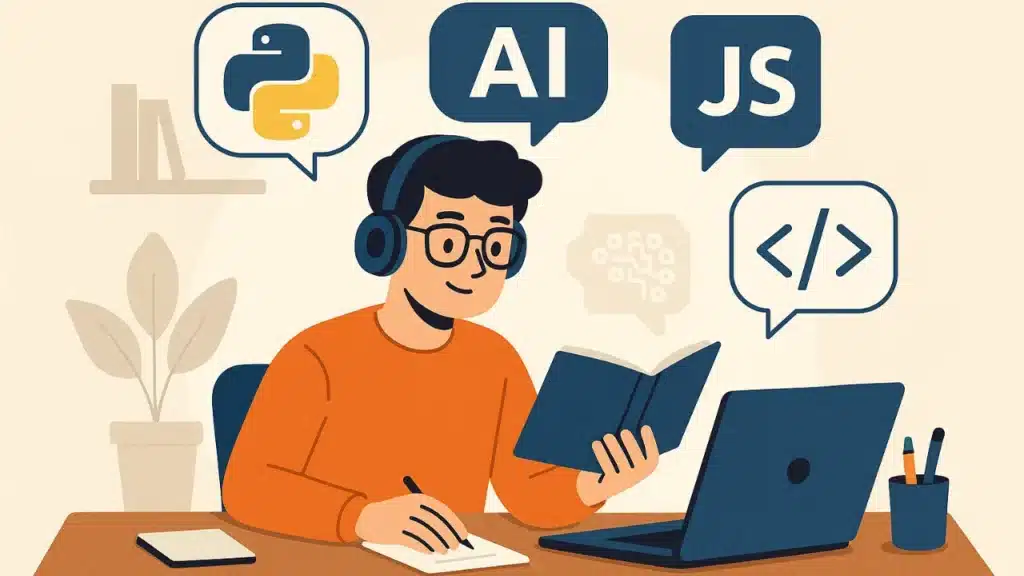The technology landscape is changing quickly due to artificial intelligence (AI), which is increasing demand for developers, engineers, and similar professionals.
Which programming language is best for artificial intelligence? is a question that newcomers to this field frequently ask. The answer to this question is not simple or universally applicable, as you might have expected.
The “best” computer language for AI depends on your objectives and projects, even though there is a clear favorite. We’ll explore the best computer languages for different objectives and project types in this guide, which will focus on the top languages driving AI.
To avoid AI detection, use Undetectable AI. It can do it in a single click.
Table of Contents
What are AI Computer Languages?

Applications that mimic human intelligence can be created using AI computer languages. These computer languages enable the development of algorithms that can learn from data and make decisions.
Every language has a unique set of libraries and frameworks that help with tasks like data interpretation, autonomous driving, and speech recognition. It is crucial to select a language that makes coding easier and provides libraries designed for specific tasks like data analysis and machine learning.
For instance, R is preferred for statistical analysis, but Python is well-known for libraries like TensorFlow and PyTorch.
The foundation of intelligent systems is made up of AI computer languages, which combine code with the ability to effectively manage challenging AI-specific tasks.
Best Computer Languages for AI

Python
Python is widely regarded as the best AI computer language for AI and the preferred option for machine learning professionals around the globe. There is a good reason for its dominance in the AI and ML space. Because Python is simple and easy to use, it encourages readability and lowers the learning curve for beginners.
Because of this, Python is a great starting point for anyone wishing to learn more about artificial intelligence and machine learning. The language’s extensive ecosystem of libraries and frameworks intended to simplify AI and ML development is where its true strength resides.
Read Also >>> Tools for Machine Learning Engineer in 2025
Building complex machine learning models is now easier than ever due to industry-standard tools like TensorFlow, Keras, PyTorch, and Sci-kit-learn. These libraries provide high levels of abstraction, pre-built components, and algorithms that can greatly speed up the development process.
Furthermore, Python’s widespread use has attracted a thriving developer and research community that consistently advances the language’s artificial intelligence capabilities.
Python is arguably the greatest language to learn for machine learning because of the wealth of resources, tutorials, and documentation that make assistance easily accessible through a search query.
C++
Python’s computational speed limitations are a significant drawback to be aware of, as C++ offers optimal execution speed, latency, and performance. Because C++ code performs better, many AI Python libraries actually use it internally. It’s possible that C++ is the best computer language for AI and ML applications that require high performance.
For applications like real-time systems and robotics, where speed and efficiency are crucial, C++ is the preferred language due to its unparalleled control over system resources and memory management.
Though fewer in number than Python’s, C++ offers ML libraries like PyTorch, TensorFlow, mlpack, Caffee, and OpenNN that offer a robust set of tools for performance-driven developers. In use cases where milliseconds count, the language’s speed and efficiency are crucial.
On the other hand, complexity is the trade-off. Because of its complex syntax and lower-level programming model, which necessitate a deeper comprehension of memory management and system architecture, C++ has a steeper learning curve.
Because of its complexity, C++ may not be as well suited for projects with short turnaround times or rapid prototyping. Nevertheless, C++ offers the possibility of producing some of the most effective AI and ML applications available if you are prepared to put in the time to become proficient in it.
R
In the field of statistics and data analysis, R has a special place. R, which was created especially for statistical computing, offers a great setting for creating machine learning models that mainly rely on statistical techniques.
The language’s strength is its extensive collection of packages for statistical modeling, data manipulation, and visualization, including the ggplot2 library, XGboost, Gmodels, and mlr. Particularly impressive are R’s data visualization features, which allow for insightful and excellent graphical representations of data.
R is not appropriate for production settings, and its steep learning curve may be difficult for some users. R, however, is among the best computer languages for AI and ML for people with a background in or strong interest in statistics, especially when statistical rigor is a top concern.
Java
Java’s stability, scalability, and extensive feature set have made it a mainstay in enterprise software development for a long time. If you are working on large-scale, commercial projects, it is a contender for the best computer language for AI.
Because Java is object-oriented, it can handle complex systems, which is a common feature of AI applications.
It has numerous libraries that can be used to preprocess data tasks and build neural networks. A strong foundation for machine learning is offered by libraries like Deeplearning4j, Deep Java Library, and Apache OpenNLP.
Java’s performance, made possible by the Just-In-Time (JIT) compiler, and its extensive industry use make it a dependable option for developers wishing to work on strong AI systems, even though it may not be as nimble or concise as Python.
Like the other languages discussed, Java has a high learning curve that may put off some developers, but for those who are already comfortable with its environment, it can be a great tool for developing intricate enterprise solutions.
JavaScript
Although some people may not be surprised by JavaScript’s involvement in AI and ML, its versatility and widespread use make it a crucial language to take into account, particularly for those wishing to incorporate AI into web applications.
It enables you to run code both server-side, like with Node.js, and client-side, in the browser. It is therefore a practical and adaptable “full-stack” choice. JavaScript’s native AI feature addition to your application is another benefit.
Despite being one of the most widely used programming languages, JavaScript has some limitations that should be noted. It lacks comprehensive data science and machine learning libraries, is not advised for demanding AI workloads, and has limitations when running workloads in the browser.
Julia
In 2012, Julia, a more recent programming language, was introduced with the intriguing promise of being as fast as C, as general as Python, and as statistics-friendly as R. It appears to have fulfilled its promise, as evidenced by the 45 million+ downloads and increasing community usage.
Let’s dissect a few straightforward analogies. Julia uses a JIT (just in time) compilation, which enables faster execution than Python, which is interpreter-based. Like JavaScript, it is a dynamically typed programming language with better syntax than C and C++, as well as an integrated package manager.
Julia is known for its Flux, Pluto, Makie, MLJ, and Tensorflow libraries. Despite Julia’s many benefits, writing code from scratch in situations without libraries may require more time. But as it continues to gain popularity, this more recent programming language is a developing story that is worth watching.
Scala
Because Scala is scalable and integrates with Apache Spark, it performs exceptionally well in machine learning and artificial intelligence. It works well for creating AI systems because of its Java compatibility and functional programming features.
When used in conjunction with Apache Spark, Scala is particularly adept at managing large-scale AI applications and handling data and functional programming. Breeze, DeepLearning4j, Scopt, Spark MLlib, and Apache Spark are the best Scala AI packages and libraries.
Scala is utilized in settings where complicated algorithmic problems and large-scale data processing are common. This language has special benefits in systems engineering and big data integration, and it supports a wide range of AI roles.
Lisp
Lisp is used for reasoning tasks like language processing because of its versatility. Its ability to work with symbols and data structures makes it useful for tasks involving symbolic reasoning.
McAll, OpenCyc, Applicative Common Lisp, and the Common Lisp User Environment are the top Lisp AI packages and libraries. A number of Lisp versions, including Apache CLIME and GNU CLisp, have functions or libraries built for AI-related tasks.
Lisp offers a rich environment for investigating and instructing AI concepts, making it particularly useful in research, education, and the upkeep of legacy AI systems.
Haskell
Code written with Haskell is dependable and clean because of its robust typing and functional programming. This makes it perfect for teaching fundamental programming concepts, researching AI, and developing new algorithms.
Because Haskell emphasizes clean, dependable code from functional programming and strong typing, it is used in AI research, algorithm prototyping, and education. HLearn, BayesBayes, Halcyon, and BioCondor are the leading Haskell AI packages and libraries.
Haskell is a favored tool for AI researchers and developers in domains needing high precision and dependability because of its functional programming features and mathematical rigor.
Mojo
Mojo’s user code maintains speed, which simplifies AI development. In terms of library support, it is still lagging behind older languages, but it offers performance and flexibility. Mojo provides a high-performing, user-friendly language for creating scalable and effective AI applications.
A promising new language is Mojo. It is still in the early stages of development, though, and has not yet been widely adopted by the industry. There are currently no established positions that specifically call for Mojo expertise.
How to Learn AI Computer Languages?

In order to begin your AI journey, you must first master fundamental concepts like statistics and mathematics (such as linear algebra and calculus), which are essential for comprehending AI algorithms and operations. Given Python’s ease of use and the wealth of resources available for AI, programming expertise is crucial.
Implementing AI solutions requires the ability to manipulate data and comprehend data structures. Your proficiency in AI can be efficiently increased by regularly updating these abilities through real-world projects and focused learning paths.
FAQs about Best Computer Languages for AI
What is the best programming language for AI development?
When considering the best programming language for AI development, Python often tops the list due to its simplicity and extensive libraries for machine learning.
Why is Python considered the best AI programming language?
Python is favored for AI because of its readability, ease of learning, and a rich ecosystem of frameworks like TensorFlow and PyTorch that facilitate machine learning.
Are there other programming languages used for AI?
Yes, languages like R, Java, C++, and Julia are also popular for AI development, each offering unique advantages depending on the specific use case.
What are the top 10 AI programming languages?
The top 10 AI programming languages include Python, R, Java, C++, JavaScript, Lisp, Prolog, Scala, Swift, and Julia.
How do I choose the best programming language for AI?
Choosing the best programming language for AI depends on factors such as the specific project requirements, your familiarity with the language, and the available libraries and frameworks.
Conclusion: Best AI Computer Languages
In conclusion, the best computer language for AI and machine learning is the one that fits your skill set, project requirements, and organizational or personal objectives. Every language discussed above has special advantages and works best for specific kinds of tasks in the fields of AI and machine learning.
Python is a great starting point for anyone wishing to get started in AI and ML because of its robust community, large library, and ease of use. C++ might be the best choice for applications that require high performance.
R is incomparable for tasks requiring extensive statistical analysis, while Java is still a formidable competitor in enterprise settings. When it comes to incorporating AI capabilities into web applications, JavaScript is essential, and Julia is a fascinating newcomer.


